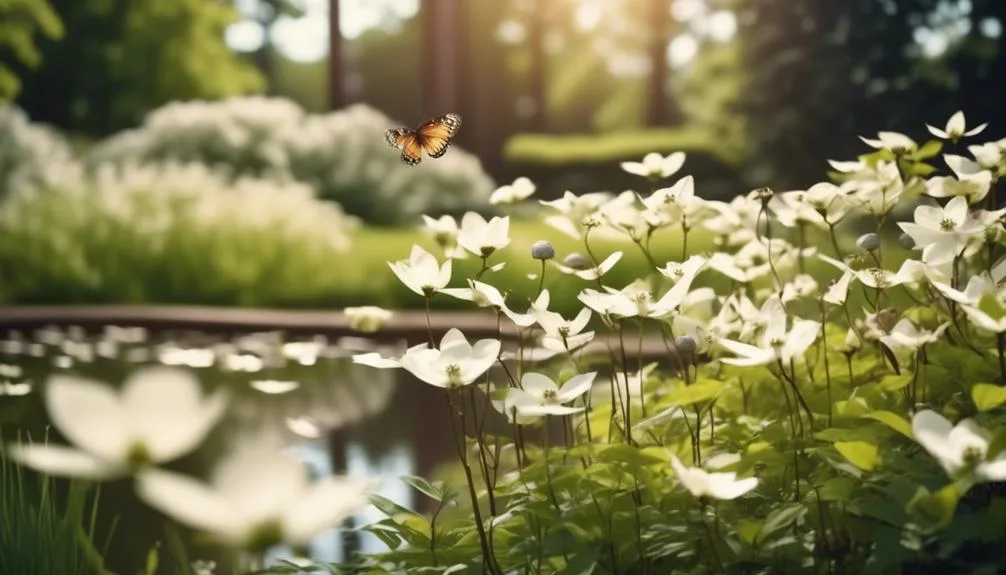Creating a wildlife habitat in your backyard with dogwood trees is like building a bustling city for animals. These trees not only look beautiful but also provide food and shelter for various wildlife.
But how can you use dogwood trees to make a thriving habitat for creatures big and small? Let's explore how to turn your outdoor space into a haven for wildlife, allowing nature's beauty and harmony to thrive.
Benefits of Dogwood Trees for Wildlife
Dogwood trees provide essential food and shelter for a variety of wildlife species, making them a valuable addition to any habitat.
The flowers of dogwood trees attract pollinators such as bees and butterflies, contributing to the overall health of the ecosystem. These pollinators are essential for the reproduction of many plants, making dogwood trees a crucial component of a thriving habitat.
Additionally, the dense branches and foliage of dogwood trees provide shelter for birds, small mammals, and insects. This shelter not only offers protection from predators but also serves as a safe nesting and breeding ground for various wildlife species.
Choosing the Right Dogwood Species
After understanding the benefits of dogwood trees for wildlife, it's crucial to carefully select the right dogwood species to maximize their impact on your habitat. When selecting dogwood species, consider factors such as the climate and soil conditions in your area.
The two most common types are the flowering dogwood (Cornus florida) and the Kousa dogwood (Cornus kousa). Flowering dogwoods are well-suited for temperate climates and well-drained, acidic soil, while Kousa dogwoods are more adaptable to different soil types and have a later blooming period.
Both species provide berries that are a food source for wildlife, but Kousa dogwoods tend to have a longer-lasting fruit display. Proper dogwood tree care is essential for their successful growth, including regular watering, mulching, and pruning to maintain their health and beauty.
Planting Dogwood Trees to Attract Wildlife
To create an inviting wildlife habitat with dogwood trees, consider the strategic placement and optimal planting conditions that will attract a variety of species to your outdoor space. When planting dogwood trees, you can significantly enhance birdwatching opportunities and wildlife photography in your garden. Below is a table highlighting the benefits of dogwood trees in attracting wildlife:
| Benefits of Dogwood Trees for Wildlife Attraction |
|---|
| Provides shelter for birds and small mammals |
| Attracts butterflies and beneficial insects |
| Offers food sources such as berries and seeds |
Strategically planting dogwood trees in your landscape not only enhances the aesthetic appeal but also creates a thriving environment for various wildlife species. By incorporating dogwood trees into your gardening plans, you actively contribute to the conservation of local wildlife while enjoying the beauty they bring to your outdoor space.
Maintaining a Dogwood Wildlife Habitat
Maintaining a thriving wildlife habitat with dogwood trees requires consistent care and attention to ensure the health and sustainability of the ecosystem. Wildlife conservation is a priority, and to achieve this, it's essential to monitor the health of the dogwood trees, prune them regularly, and protect them from diseases and pests.
Regular watering and mulching help in maintaining the moisture levels and fertility of the soil, which are crucial for the ecosystem preservation. Additionally, removing invasive plant species and planting native wildflowers around the dogwood trees can further enhance the habitat for wildlife.
Enhancing the Wildlife Habitat With Dogwood Trees
Looking to attract more wildlife to your outdoor space? Consider how incorporating dogwood trees can enhance and diversify the habitat for local animals.
Dogwood trees provide excellent nesting sites for birds, attracting a variety of species to your garden. The dense branches and foliage offer protection and shelter for birds, encouraging them to build their nests and raise their young.
Additionally, the vibrant flowers of the dogwood tree are a magnet for butterflies, making your garden a delightful haven for these colorful creatures.
By planting dogwood trees, you can create a thriving ecosystem that supports bird nesting and butterfly gardens, adding beauty and vitality to your outdoor environment.
These trees not only enhance the aesthetic appeal of your landscape but also contribute to the overall health and diversity of the wildlife habitat.
Conclusion
Incorporating dogwood trees into your backyard can create a flourishing wildlife habitat, enriching your outdoor space with diverse bird and butterfly activity. By selecting the right species and providing proper care, you can witness the wonders of nature right outside your door.
Embrace the beauty and biodiversity these trees bring, and savor the tranquility they offer.

My interest in trees started when I first saw the giant sequoias in Yosemite.
I was a teenager then, and I remember thinking, “I need to learn more about this.”
That moment stuck with me.
A few years later, I went on to study forestry at Michigan Tech.
Since graduating, I’ve worked in a mix of hands-on tree care and community education.
I’ve spent over ten years helping people understand how to plant, maintain, and protect the trees in their neighborhoods.
I don’t see trees as just part of the landscape.
They are living things that make a real difference in our daily lives.
